Debris takes out Garmin Panoptix FLS transducer, boat still floats
Before heading from Chicago down to the Mobile, AL, I had two new holes drilled in the bottom of Have Another Day to install Garmin Panoptix PS-51 and Simrad Forward Scan forward-looking sonar transducers. Our travels down the debris-filled rivers revealed a potential problem with anything protruding below the hull, but it also showed how robustly these transducers are built.
Our departure south was already behind schedule when I decided to install the FLS transducers. So, I wasn’t able to do the wiring and commissioning work the manual suggests. Without proper commissioning, I wasn’t confident in the information they provided so I wasn’t using either one. Because I wasn’t using them I didn’t notice anything change when the Garmin Panoptix apparently took a direct hit from debris.
Our trip down the rivers included lots of high water and flood currents, and with the flooding more debris than I’ve ever seen in the water. We saw branches, tires, coolers, and full trees significantly longer than our nearly 60′ boat. During our second day on the Mississippi, the debris became so thick that avoidance became picking the smallest debris to hit. Most of our river cruising was done at about 8 knots speed through water (though our speed over ground was closer to 13-15 knots courtesy of the current) and some of the hits felt pretty significant though very few had the repetition I’ve usually heard with prop strikes.
Our arrival in Mobile marked the end of our river travel so I had a diver check the running gear. We knew we’d hit more stuff than we would have liked so I was debating a haul-out and prop swap. The diver came up with good news, the props had very minor leading edge imperfections but overall they looked good. But, he did ask what I had forward on the hull because there was some kind of wiring and a micro-chip hanging down. I quickly realized that it must be one of the FLS transducers.
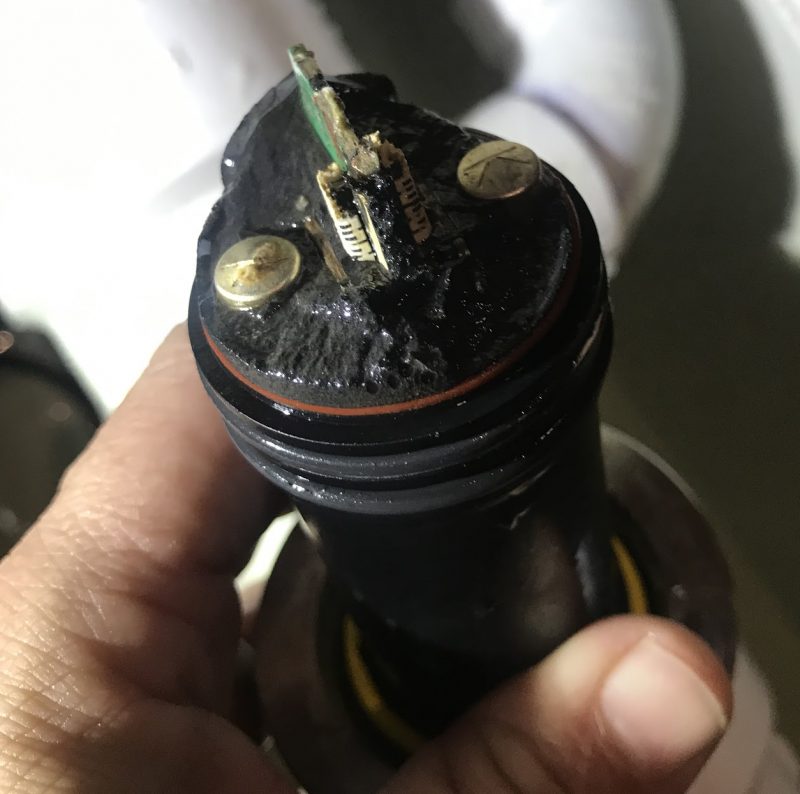
It looks like Garmin used lots of potting material in the transducer and it stood up well to catastrophic damage
Uncomfortable with having a damaged transducer hanging off the hull, I decided to swap it for a blank plug. Which took a little consulting from Ben E. because I didn’t know exactly how this type of transducer came out. Incidentally, each time I’ve done a transducer swap while in the water, I’m amazed at just how much water comes flooding in during the moment there’s nothing filling the hole. If hitting something pushed an FLS transducer out its casing, the leak would be serious.
With the plug in place, I was able to see how badly the transducer was damaged though it sheared off even with the waterline. In light of the amount of damage, I was quite pleased not to have had any leaking from the damaged ‘ducer. Careful inspection revealed heavy use of potting material and the lack of leaks proved its effectiveness.
I’m still planning to complete the commissioning of the Simrad Forward Scan and hoping to replace the damaged Garmin PS-51, but this is one of the potential pitfalls of installing anything that hangs down lower than the hull and needs a view of what’s forward.


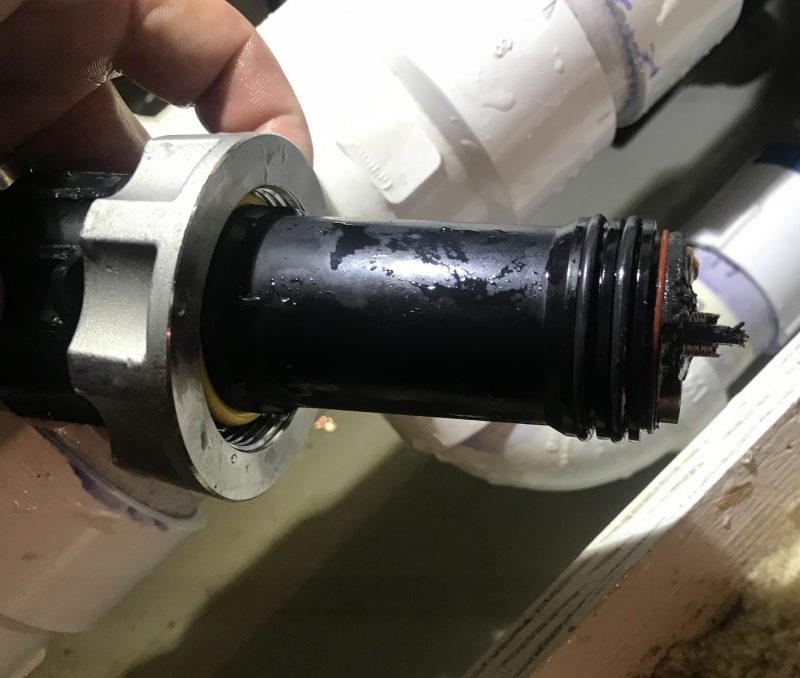

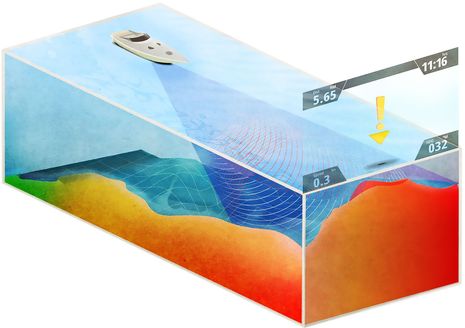
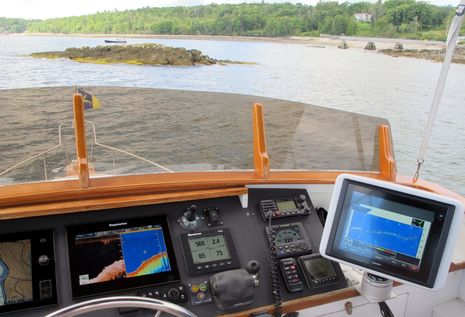
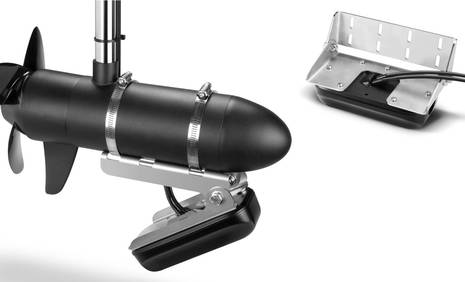








I’ve installed a few of those Garmin forward looking transducers, all three have come out and gotten replaced with a traditional transducer. One got crushed by a travel lift strap and the others got wiped off the bottom. The idea is good, but…and they definately need to install a geyser valve like the airmar transducers. There is nothing more heart stopping than when that water comes spouting out! That doesnt happen with an Airmar housing.
If you knew there was a lot of debris can you not lift it out and replace with a blank plug fitment?
Terry, I could have lifted it out though there are a couple of reasons I didn’t (though that still might not have been the right decision). First, I had hopes of doing more testing on the rivers, which was one of the spots I had in mind when I decided to compare FLS sounders. Secondly, I wanted to use the sounders in the fashion I thought was most likely and I don’t think it’s overly likely people would pull the transducers on a regular basis (which is especially true of the Garmin that doesn’t have a flapper valve to minimize water flow when you swap it). Lastly, I have to admit I was managing a lot of other things and didn’t think too much about the transducers.
First time I’ve seen a picture of the transducer. I’m surprised anybody thought that was a good idea. Is it really that important to be able to remove the transducer? No reason why it couldn’t be encapsulated in a bubble housing.
Could you put a protective piece in front of it to deflect debris like what goes in front of stabilizer fin or would that imped the effectiveness of the sonar. I just order the garmin sonar for my new build and am having second thoughts.
I had an EchoPilot FLS installed on my steel-hulled trawler when it was built in 2009. Ice damaged the transducer while in Tracy Arm (SE Alaska). Upon the next haulout for bottom paint when I replaced the transducer, I had two fins welded on either side of the transducer to (hopefully) deflect any future debris sliding along the bottom of the hull. They do not effect the transducer’s performance. A picture of the installation can be seen at:
https://1drv.ms/u/s!AgI7i7uMvwgRiJQZGuJs3jhhy5nwWQ
Well, I’ve had FLS transducers on Gizmo since 2010 — Interphase, EchoPilot, Simrad, and Garmin, in that order — and none has been damaged. And they were all installed in possibly the most exposed spot too, as shown in this entry:
https://panbo.com/changing-transducers-5200-problem/
Even a fairly gentle grounding on a shoal Maine ledge could have wiped any one of them out (hopefully shearing off). And during these nearly nine years the boat has been round trip to the Carolinas three times. I have heard or felt occaisional debris bang my hull.
Maybe I’m incredibly lucky, but I tend to think that even the smaller Simrad and Garmin stick-out transducers are pretty strong and that Ben S was unlucky in unusual debris conditions (though I can’t explain Seth’s customers 😉
All good points.
The transducers in the article you referenced are much more substantial mass and the shape better suited to deflect debris. If you hit something hard enough to knock one of those off it probably would have put a hole in the hull even if there was no transducer there.
I’m more inclined to think that transducer is intended to shear off as a protective measure because of its shape.
Hi Paul. It’s confusing but it was only the big Interphase fixed “grapefruit” that was much different. That 5/14 entry I linked to is largely about the difficulties of replacing it with the EchoPilot retractable, which is similar to the Simrad and Garmin 2-inch retractable except with 1/2″ more diameter. Then that fall in Baltimore I switched from the EchoPilot to then brand new Simrad ForwardScan…
https://panbo.com/simrad-forwardscan-bg-too-a-breakthrough-even-in-beta-testing/
… and switched to the Garmin Panoptix PS51 in late 2016, so it too has had a roundtrip south. In other words, I’ve put quite a few miles on both the FLS transducers Ben S discusses in the entry.
It’s still really hard for sonar to look ahead, but I’ve appreciated all of the systems I’ve tested, and each is better than the last. (ForwardScan was a big leap in price/performance; the PS51 is faster but has about the same range, so the big price difference is not reflected in performance.)
A word of advice for anyone installing these, they do not need to be near the bow! There is this thought process that its forward looking so it has to be up near the bow. Having installed a few now we find its better to put them back in the forward section of the engine space. Odds are good the slings wont break it off, it wont cause all the noise some have mentioned in the past from is skimming up in the water plane. You loose 20-30′ of forward view big deal… Since moving to this location I haven’t lost one yet and we’ve been installing them for at least two or three years now. Great technology for the right customer but not for all customers.
Thanks, Chris, but I’ll again play the devil’s advocate. It’s really hard to receive back and interpret sonar pings sent forward, so the effective range is quite short and thus starting as close as possible to your bow is a significant benefit.
For instance, the Simrad FowardScan only claims a forward range eight times the current depth — http://ww2.simrad-yachting.com/en-GB/Products/Transducers/ForwardScan-Transducer-en-gb.aspx — which means it can only see bottom 80 feet ahead when the boat is in 10 feet of water. And while I have seen 8x and even 10x range from ForwardScan, Panoptix PS51, and EchoPilot Platinum FLS, that’s almost always been in more than 20 foot depths. The X factor decreases as the water depth under the boat decreases. In 10 feet of water, 5X is more realistic, so even 10 feet of hull is 20% of range.
Measured from the boot stripe, Gizmo’s FLS transducers have all been about 6 feet aft and 20 inches deep. In this entry about last May’s haul out, check out the photo of the painted bottom and you can make out the PS51 just aft of the forward blocking:
https://panbo.com/eco-bottom-paint-testing-back-to-copper-and-irgarol
All the transducers mounted there have worked even at 16 knots if the seas were fairly flat, and were sometimes useful for identifying a shoaling trend in deep waters. At speeds like 5 knots when FLS might be useful is shallower water, they always worked fine regardless of sea state.
Using Ben’s example, in 10′ of water, the skipper of a vessel traveling at 16 knots has less than 3 seconds to react. If the transducer was mounted in the engine space 20′ further aft, that would further reduce your time to react by three quarters of a second.
An alert skipper might be able to dodge a submerged object but everybody knows somebody who has failed to dodge a lobster pot (and if you didn’t, you do now :). For something too large to dodge, like a shoal, it’s not likely you will be able to stop the boat in time.
Based what Ben is saying, it sounds like forward scanning transducers are only useful at very low speed, for example when you are fishing, gunkholing or passing through uncharted waters such as an inlet subject to shoaling.
Before they were acquired by Garmin, didn’t Interphase offer a phased array transducer that could see much farther in front of the boat? I think they claimed something like 1200′. I remember using one of their models with a dial that allowed you to vary the down angle of the beam so you could see further forward.
“It sounds like forward scanning transducers are only useful at very low speed” — Bingo! The main use of the FLS tech being discussed here is when you already know you’re in dicey waters. Secondarily, a head’s up on rapidly rising bottom that’s 400 feet ahead when you’re doing 16k in 50 feet of water can be helpful and, incidentally, the alarm abilities of Simrad and Garmin FLS are especially good because they are network devices.
The Interphase FLS I sledge-hammered out of Gizmo in 2014 — https://goo.gl/r7mwVs — was part of a PC system that retailed for nearly $10,000. It could see pretty far ahead in deep water — either vertically or horizontally, and really fast — but was much better at imaging fish than bottom. Incidentally, this 2010 overview of forward and side-scanning sonar is still fairly pertinent, except that both have become much more integrated and often much less costly:
https://www.yachtingmagazine.com/whats-ahead-sonar/
I’m curious what the display of the Garmin was showing when it was damaged? Was it acting functional in any fashion, or had it gone dead to the network?
Thanks!
– Chris
I am installing a Garmin PS-51 on my boat where I already have an airmar plastic housing that I am not using (perfectly horizontal and with a geyser valve). Can I use it or is a plastic housing more dangerous than the Garmin stainless steel housing in case I hit something? Thanks
What’s the trick to getting the PS51 out from inside. you mentioned Ben E. helped you out.
I’m struggling to screw it off the thread.
Steve, I have a packing nut wrench that has been helpful with loosening the threaded caps of transducers:
https://www.amazon.com/Allied-51008-Adjustable-Packing-Wrench/dp/B01N4PBJ4V/
But I have sometimes had trouble pulling the ducer after the cap was unthreaded. A diver and one well-placed hammer tap did the trick once, but usually I succeed in prying it out with a thin-bladed flat screwdriver. However, I did break the flange on one once, maybe the PS51. In retrospect, regular removal and greasing is a good idea.
Thanks Ben. Good tips. I think my problem is all the growth I picked up in Nuku Hiva. Will wait to we get out of the marina, give it another clean and maybe threaten it will a hammer